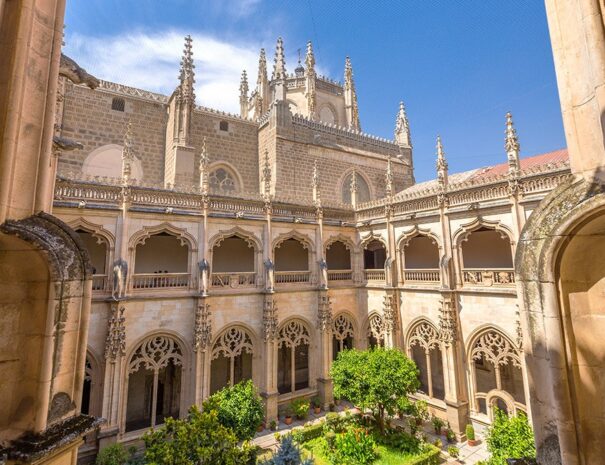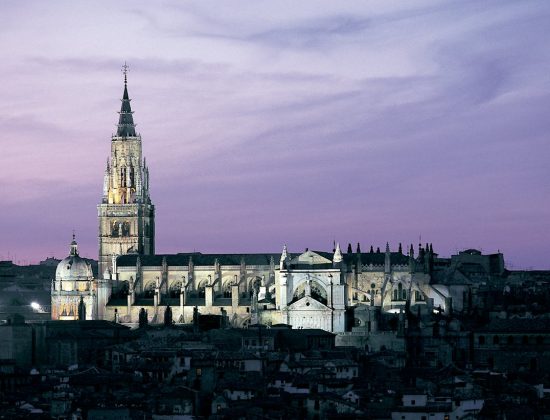
Monastery of San Juan de los Reyes in Toledo
The Monastery of San Juan de los Reyes in Toledo is one of the “must see” sites to visit while in the Medieval City of Toledo. Check it out! … Read More
The El Greco Museum is housed within the 16th-century estate, located in the heart of Toledo’s old quarter, in the city’s Jewish quarter. The museum is dedicated to the Mannerist painter Doménikos Theotokópoulos (known as El Greco) who was originally born in Crete but who produced most of the of his work in the city of Toledo.
The museum was inaugurated in 1911 and compiles many works by the Cretan artist. It houses a wide collection of canvases by this artist from the Golden Age. The museum consists of two buildings: a house with a patio from the 16th century, and an extension that was added at the beginning of the 20th century. Inside you will find numerous works by El Greco, especially from the artist’s last period, as well as canvases by other Spanish painters of the 17th century, furniture from the same period and ceramics from Talavera de la Reina. The Greco museum should not be confused with Santo Tome church, the church that can also be visited and which holds the famous Conde Orgaz burial painting also in Toledo.
The museum holds a large part of the works created by El Greco during his lifetime.
The main highlights of the whole exhibit are “View and Plan of Toledo” and “The Tears of San Pedro”. The museum also displays several paintings y other well-known Spanish artists including Luis Tristán, Murillo, and Valdés Leal.


The whole museum is created around the figure of El Greco and the influence of his work and personality in Toledo in the early seventeenth century. The house itself is also part of the exhibit. The full complex was finished at the beginning of the 20th century, but the original museum was housed in a 16th-century estate. The history of the “house” and the museum, as well as the figure of the Marquis de la Vega-Inclán, who created the museum, are highlighted as well. The house is not, in fact, the original house of the painter, and it was thanks to the Marquis de la Vega-Inclán, that the figure of El Greco was recuperated from the annuls of history. The museum also includes several Múdejar-era caves, as a sample of the past of the current museum and the garden, recalling the figure of the Marquis and his political-cultural personality within the Toledo environment of his time.
The museum’s collection features a significant number of paintings by El Greco from the 16th and 17th centuries, that are ¡ representative of his life and work, as well as the culture and society of Toledo at the time.
The museum features a vital set of paintings from the artist’s last period of work. Among these pivotal works are the 13 paintings that make up the Apostolate, the View and Plan of Toledo, the Tears of San Pedro, which we have mentioned before, and a select group of portraits.
In the thirty-seven years that El Greco lived in Toledo, his style was profoundly transformed. He went from an Italianate style in 1577 to evolve in 1600 to a very dramatic, distinctive, and original one, systematically intensifying the artificial and unreal elements in his paintings.
This new style he created is on display in the museum and it is characterized by: small heads resting on increasingly long bodies; the increasingly strong and strident light, whitening the colors of the clothes, and a shallow space with an overcrowding of figures.
In his last fifteen years, El Greco took the abstraction of his style to even new limits. His last works have an extraordinary intensity, to the point that some scholars looked for religious reasons, assigning him the role of visionary and mystic. He managed to impress his works with a strong spiritual impact, reaching the goal of religious painting: inspiring emotion and also reflection.
From March 1st to October 31st: 9:30 a.m. to 7:30 p.m. from Tuesday to Saturday
From November 1st to February 28th: 9:30 a.m. to 6:00 p.m. from Tuesday to Saturday
Sundays and other holidays all year round: 10:00 a.m. to 3:00 p.m.
The Museum remains closed:
Every Monday; January 1 and 6, May 1, December 24, 25 and 31, and some local holidays.
Box office closes 15 minutes before the end of visiting hours.
General rate: 3 euros
Reduced rate: 1.50 euros
Free entry: Saturdays from 2:00 pm; Sundays; on November 16 (World Heritage Day), May 18 (International Museum Day), October 12 (National Holiday of Spain), and December 6 (Spanish Constitution Day).
The museum is located in the south of downtown Toledo, near the Tajo River, in the city’s old Jewish Quarter. It is very close to the famous Santa María la Blanca synagogue, and the Church of San Bartolomé.

The Monastery of San Juan de los Reyes in Toledo is one of the “must see” sites to visit while in the Medieval City of Toledo. Check it out! … Read More

The Toledo Cathedral, known as La Primada is the main cathedral of Toledo. Check out our full guide to this spectacular cathedral. … Read More
is proudly powered by WordPress